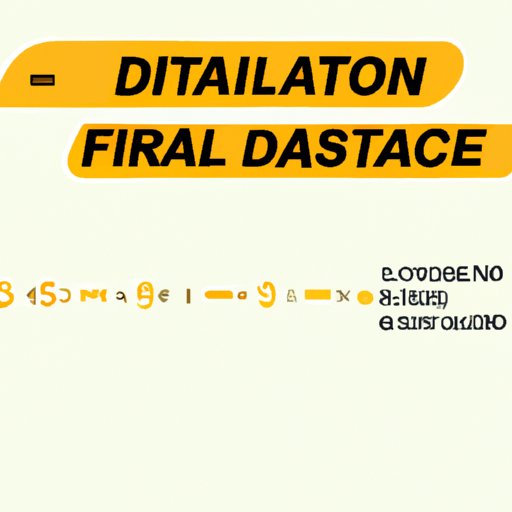Introduction
Distance traveled is a term used to describe the amount of space an object has covered in a given amount of time. In order for an individual or organization to accurately measure and analyze distances traveled, it is essential to have an understanding of the formula used to calculate it and the tools available to do so. This article will provide an overview of how to calculate distance traveled, including an explanation of the formula, examples, a guide to using an online calculator tool, a manual calculation guide, common objects and their distances traveled, and accuracy factors.
Formula and Examples
The formula for calculating distance traveled is fairly straightforward. It is simply the product of the speed and time (d = st). Speed is measured in meters per second (m/s) and time is measured in seconds (s). For example, if an object is traveling at a speed of 10 m/s for 10 seconds, then the distance traveled would be 100 meters (10 x 10 = 100). To illustrate this further, if a car is traveling at a speed of 50 km/h for 2 hours, then the distance traveled would be 100 km (50 x 2 = 100).
Online Calculator Tool
There are several online calculators available to help individuals and organizations quickly and accurately calculate distance traveled. Most of these tools require users to enter the speed and time values into their respective fields and the calculator will automatically generate the distance traveled. Additionally, many of these calculators also allow users to select the unit of measurement they prefer. For example, if the user wants to calculate the distance traveled in miles, they can simply select “miles” as their unit of measurement in the drop-down menu.
Manual Calculation Guide
In some cases, it may be necessary to manually calculate the distance traveled. This can be done by following a few simple steps. First, the speed must be converted to meters per second (m/s). If the speed is given in kilometers per hour (km/h), then the conversion rate is 1 km/h = 0.277778 m/s. For example, if the speed is 75 km/h, then the speed in m/s is 20.833 m/s (75 x 0.277778 = 20.833). Next, the time must be converted to seconds (s). If the time is given in hours (h), then the conversion rate is 1 h = 3600 s. For example, if the time is 3 hours, then the time in seconds is 10800 s (3 x 3600 = 10800). Finally, the distance traveled can be calculated by multiplying the speed in m/s by the time in s (d = st). Using the previous example, the distance traveled would be 216,998 m (20.833 x 10800 = 216,998).
Units of Measurement
When calculating distance traveled, it is important to consider the unit of measurement being used. The most common unit of measurement for distance traveled is meters (m). However, other units of measurement such as kilometers (km), feet (ft), miles (mi), and yards (yd) are also commonly used. It is important to note that when using these units of measurement, the speed and time values must be converted accordingly.
Common Objects and Their Distances Traveled
To gain a better understanding of how to calculate distance traveled, it is helpful to look at some examples of common objects and their distances traveled. For instance, a car traveling at a speed of 60 mph for 4 hours would travel a total distance of 240 miles (60 x 4 = 240). Alternatively, a plane traveling at a speed of 500 mph for 6 hours would travel a total distance of 3,000 miles (500 x 6 = 3,000). Finally, a train traveling at a speed of 30 mph for 8 hours would travel a total distance of 240 miles (30 x 8 = 240).
Accuracy Factors
It is important to keep in mind that there are certain factors that can affect the accuracy of a distance traveled calculation. These include the type of terrain, wind speed, and weather conditions. For instance, if a car is traveling on a flat surface, the distance traveled is likely to be more accurate than if the car is traveling on a hilly or mountainous terrain. Additionally, wind speed can affect the accuracy of a calculation since it can cause the car to move faster or slower than its intended speed. Finally, weather conditions such as rain or snow can also impact the accuracy of the calculation.
Conclusion
Calculating distance traveled is an important skill to have, especially when trying to analyze the movement of an object over a period of time. With the help of the formula provided, an online calculator tool, and a manual calculation guide, individuals and organizations can accurately measure and analyze distances traveled. Additionally, having an understanding of the different units of measurement and accuracy factors can help ensure the accuracy of the calculation. All in all, calculating distance traveled is an invaluable tool for measuring the motion of an object.
(Note: Is this article not meeting your expectations? Do you have knowledge or insights to share? Unlock new opportunities and expand your reach by joining our authors team. Click Registration to join us and share your expertise with our readers.)
